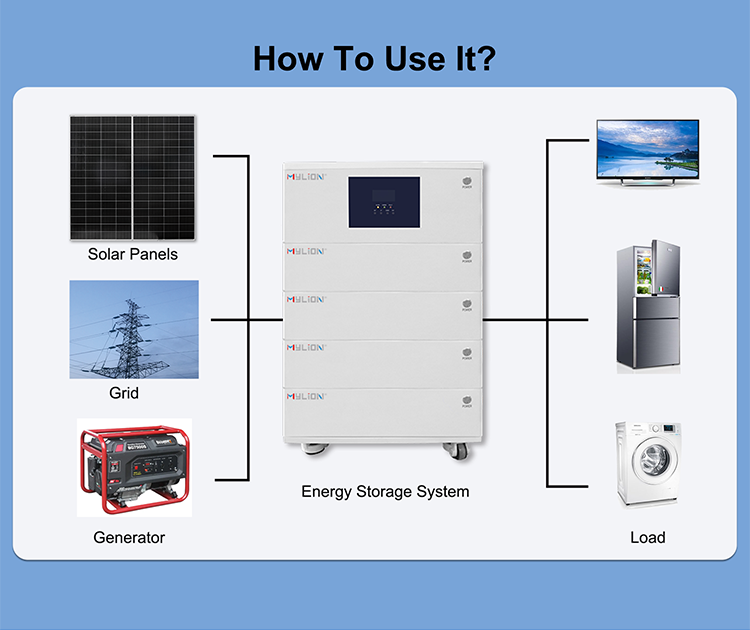Storage systems for battery energy have revolutionized how we store and manage energy. With the rising need in renewable energies as well as the requirement for efficient and reliable energy storage solutions battery storage systems for energy have been recognized as a game changer in the world of energy storage.
In this thorough guide, we’ll dive deeper into batteries for energy storage and explore their basic advantages, applications and the future. If you’re an owner of a business, homeowner or an energy enthusiast this guide will arm you with the necessary information and insight to help you navigate the maze of batteries for energy storage.
Battery energy storage Systems are rechargeable battery systems that store energy from a variety of sources, including solar arrays or even the grid of electricity, and then supply that energy to homes and businesses as they require it. These systems are equipped with advanced technology that lets them accomplish a variety of functions, including load shifting, peak shaving as well as emergency backup. the integration of renewable energies.
The idea that solar arrays can be combined with batteries isn’t new. The first pioneers of solar energy typically connected batteries to solar arrays in order to store energy for use in the night. But, today’s technology for battery storage has advanced dramatically, with integrated inverters as well as computers to control the system. These turnkey, all-in-one systems are easy to set up and maintain, as well as weatherproof, which makes them a secure and reliable option for storage of energy.
Batteries for energy storage have numerous applications. In commercial situations, they could be utilized to reduce peak demand load shifting, emergency backup grid services, and microgrids. For homeowners battery energy storage systems, they can be ideal for solar self-consumption, off grid living and backup in case of emergency.
The benefits that battery storage technology offers are many. They enable businesses to remove the cost of demand on their bills for utilities, cut down on the cost of energy by shifting load and provide stable backup power in the event of power outages. For homeowners battery energy storage systems permit self-consumption and consumption from solar power, decrease dependence on grid power, and give security in times of need.
Like any other technology battery energy storage systems have their own issues and risks. This includes the initial cost of installation, maintenance, and the compliance with safety and regulatory standards. It is essential to take care of these issues and mitigate the risks that come with batteries energy storage systems in order in order to ensure their maximum performance and long-term viability.
Since the requirement for energy from renewable sources and storage for energy continues to increase government and regulatory bodies have been implementing compliance regulations and standards for batteries for energy storage. It is vital for installers, manufacturers and those who use these systems to be aware and adhere to these rules to ensure the safety and effectiveness the installations.
In the near future, the potential of batteries for energy storage promises great things. The advancements in battery technology as well as the decrease in cost and growing energy requirements, will encourage the use as well as integration into the energy system. As energy storage systems for batteries are more affordable and efficient they will play a significant role in bringing about green and sustainable energy future.
In the next sections of this comprehensive guide we will go over the fundamentals about battery storage technologies, their benefits and advantages, their application and usage scenarios as well as the risks and challenges that they pose, their regulatory compliance, the upcoming trends and prospects regarding these types of systems. Keep an eye out for a deep look into the world that is battery storage.

Understanding the Basics of Battery Energy Storage
BESS, or Battery Energy Storage Systems (BESS) are changing the method we store and use energy. These systems harvest energy from renewable sources such as wind and solar energy and store the energy in rechargeable batteries and release it whenever needed. What is their process as well as what exactly are most important elements of BESS?
The core of BESS is the battery system that is the system itself. It is composed of battery cells which convert chemical energy into electrical energy. The cells are organized into modules that can then be combined to create battery packs. Battery management systems (BMS) guarantees the security and performance for the entire battery. It checks the health of the batteries, evaluates their parameters and safeguards them from threats.
To transform the direct current (DC) generated by batteries to alternating current (AC) which can be utilized by businesses and homes BESS BESS needs an inverter, or power conversion system (PCS). PCS PCS will be responsible for bi-directional flow of energy which allows for charging and discharging of batteries.
A system for managing energy (EMS) manages the operation of BMS PCS, BMS as well as other parts that comprise the BESS. It analyzes and collects energy information, maximizing the power consumption for the entire system. The EMS ensures energy efficiency and optimizes the efficiency for the BESS.
In addition to these essential components, a BESS can contain safety systems including fire protection smoke detection, fire control, as well as temperature controls. These systems control the conditions within the BESS and react to any emergency to ensure the safety of the system.
In terms of battery technology lithium-ion (Li-ion) batteries are the most commonly used in BESS. They have a an energy density that is high, a longer life span, and speedy response times. Other types of battery like lead-acid, sodium-sulfur, nickel-cadmium, and flow batteries, possess their own distinct properties and functions.
BESSs come with a range of benefits and uses. They can assist in balancing the burdens between peak and off-peak times, thus reducing the cost of electricity. They allow energy time-shifting, permitting buying electricity with lower costs, and then its usage and sale to customers at more expensive costs. BESSs can also supply backup power in the event of grid failures they also aid in the control of voltage and frequency, and help in incorporation of alternative energy sources.
Although off-the-shelf BESSs are available, custom-built systems have the benefit of tailoring solutions for specific needs. But, the process of creating an individual BESS requires expert knowledge in batteries, power electronics and software development. There are other aspects to consider like manufacturing, certification, as well as conformity with the regulations.
In the end BESSs, or battery energy storage devices are revolutionizing the way we store and use energy. Through their fundamental components and cutting-edge battery technologies, BESSs offer a wide variety of benefits and applications. Custom-built or off-the-shelf, BESSs play an essential role in the shift towards a more sustainable and cleaner environmentally sustainable energy future.
The Advantages and Benefits of Battery Energy Storage Systems
Batteries energy storage (BESS) provide a broad variety of benefits and advantages which make them a vital part of the current energy landscape. From improving the stability of grids to enabling integration of renewable energy sources, BESSs provide numerous advantages which contribute to the creation of a more sustainable and efficient energy future.
Grid Resiliency and Stability one of the main benefits that comes with BESSs is their capacity to increase the stability and reliability of grids. By keeping excess energy in times of low demand and then releasing it at times of peak demand, BESSs help balance the demand and supply of electricity and reduce the load on the grid, and reducing the possibility of blackouts or power interruptions.
Renewable Energy Integration as the world shifts to an environmentally friendly and environmentally sustainable mix of energy sources, BESSs play a crucial part in the integration of renewable energy sources such as wind and solar to the electric grid. Through the storage of excess energy from intermittent sources BESSs provide a constant as well as reliable source of power even if the sun doesn’t shine or the wind doesn’t blow.
Load Management, Demand Response BESSs support demand response and load management strategies for users by allowing them to shift their energy consumption during peak hours to off-peak periods. This helps not only reduce the price of electricity for consumers, but also aids utilities in optimizing their grid operations and reduce the necessity of costly infrastructure improvements.
Disaster Preparedness and Backup Power in the event of an electrical interruption or grid failure, BESSs can provide backup power to critical facilities as well as homes. This helps ensure that vital services, like hospitals and emergency response centers and telecommunications networks, are in operation during times of emergency, thus enhancing overall resilience of the community.
Environment Efficiency as well as Emissions Reduction In facilitating to integrate renewable sources of energy and decreasing the dependence on fossil fuel-based power production, BESSs contribute to environmental efficiency and emission reduction. Utilizing battery-based energy that is clean and stored in batteries aids in reducing greenhouse gas emissions as well as reducing the effects of climate changes.
Cost Savings and energy Efficiency BESSs provide significant savings on costs as well as energy efficiency advantages. Through optimizing energy use as well as reducing demand peak BESSs can help consumers cut their electric bills and save on the cost of energy. In addition, the use of BESSs will help reduce the need for costly grid infrastructure and result in cost savings over the long term for grid operators and utilities.
The ability to scale and flexibility BESSs are extremely versatile and adaptable, which allows to be easily integrated into various software and configurations. No matter if it’s a smaller-scale home system, or massive infrastructure for utility use, BESSs can be tailored to meet your specific needs for energy storage, and are easily extended or upgraded when requirements alter.
In the end batteries energy storage systems provide a variety of benefits and advantages which contribute to an efficient sustainable, reliable, and long-lasting energy future. From improving reliability and stability of the grid to allowing renewable energy integration, and delivering savings on costs, BESSs play a crucial part in shaping the energy landscape of the future. As the need for sustainable and reliable energy increases and the need for battery energy storage systems will rise, making them an integral part of the current energy infrastructure.

Exploring the Applications and Use Cases of Battery Energy Storage
BESS, or battery energy storage devices (BESS) are revolutionizing how we store and use energy. Due to their versatility and dependability, BESSs have found applications across a variety of industries and sectors. Let’s take a look at some principal applications and uses of BESSs for energy storage.
Renewable Energy Integration One of the main uses of BESS is incorporation of energy from renewable sources, such as wind and solar power. BESSs can conserve excess energy produced in times of high production, and release it at times of peak demand. This provides an uninterrupted and stable power supply regardless of renewable sources being infrequent.
Microgrids Batteries energy storage is a vital element of microgrids. These are power grids that are localized and can be operated independently or together with the main grid of utilities. BESSs in microgrids offer back-up power in times of disruption allow load shifting and enhance general stability as well as effectiveness of the grid.
Grid Stabilization BESSs are essential in stabilizing the electric grid through voltage and frequency regulation. They are able to react quickly to changes in demands and supplies, which ensures an uninterrupted and stable supply of electricity. This is crucial in areas with a high concentration and use of alternative energy sources.
Demand Shaving, Peak and Control: BESSs can reduce the demand for electricity in the form of storing energy in off-peak times and releasing the excess energy during peak demand times. This helps not only reduce the load on the grid, but also helps reduce electricity costs for consumers.
The Transmission and Distribution Deferral BESSs can reduce the need for expensive improvements to the distribution and transmission infrastructure. By the storage of excess energy as well as providing reserves, BESSs can relieve stress on power lines that are overloaded and help prevent congestion in transmission networks.
Electronic Vehicle Charging Infrastructure The increasing use in electric vehicle (EVs) has led to a higher need to build charging infrastructure. BESSs are able to play an important function in managing the charge demand by storing the surplus energy during periods of low demand and then supplying it at times of peak charging. This can help optimize the utilization of the existing infrastructure and lessens the load of the grid.
Commercial and Industrial Applications: BESSs are found in wide applications in commercial and industrial facilities to balance load as well as peak shaving and backup power. They can reduce costs for energy, increase the quality of power, and guarantee uninterrupted operation during power outages.
Residential Energy Management Battery energy storage is increasingly becoming a common practice in residential settings, especially when combined to solar PV system. BESSs let homeowners save surplus solar power during daytime, and make use of it later in the evening, or in power outages. This reduces the need for the grid and increase self-consumption of renewable energy.
In the end batteries energy storage systems can be utilized for a variety of applications and provide numerous advantages in a variety of industries. From the integration of renewable energy sources to stabilizing grids and improving the management of energy, BESSs are transforming the ways we produce storage, use, and generate electricity. As technology improves and costs decrease and battery storage becomes more popular, the use of energy storage is likely to rise, clearing the way to an environmentally sustainable and durable energy in the future.
Addressing Challenges and Managing Risks in Battery Energy Storage Systems
As batteries energy storage devices (BESS) are continuing to gain popularity and are becoming an integral to the energy system, it’s crucial to consider the potential challenges and risks that come with this type of technology. Although BESS has many advantages however, there are certain issues that must be overcome in order to achieve the successful deployment and operation.
One of the biggest challenges for battery energy storage is the price. Although the cost of batteries has decreased in recent years, it is a substantial investment. However, as demand for energy storage rises and technology improves will bring about more cost savings in the near future.
Another problem is the short life span of batteries. As time passes, batteries age and are unable to store energy and provide it. The degradation of batteries can be affected by a variety of factors, including temperatures, discharge depth as well as charging and discharging rates. To overcome this problem, proper management of the battery and maintenance procedures are essential. Regular monitoring as well as testing and replacing of batteries will guarantee optimal performance and prolong their life span.
Safety is a crucial aspect in the context of battery storage for energy. Although modern battery technology has enhanced security features, there is still the possibility of fire, thermal runaway or explosion. Proper installation of fire suppression systems and compliance with safety rules are vital to minimize the risks. Furthermore, training and education for those who are involved in the maintenance and operation of BESS can keep accidents from happening and ensure the safe use of the batteries.
Integration with the current power grid can be a issue for batteries for energy storage. The fluctuating power sources that are renewable like wind and solar could pose difficulties in the balance between demand and supply. BESS can assist in addressing this problem by storing excess energy during times of high production and then releasing it in times of peak demand. But an effective Grid integration as well as coordination is required to ensure an efficient and smooth operation.
Environmental impact is an additional consideration when it comes to battery energy storage. While batteries provide a cleaner and environmentally sustainable alternative to traditional power sources of energy, their manufacturing and use can result in environmental impacts. Recycling and disposal properly from batteries after the conclusion of their lifespan is vital to limit environmental impacts.
In the end, although battery energy storage systems provide many advantages but there are some dangers and challenges that need to be dealt with. This includes cost of battery lifetime safety grid integration, battery lifespan, and environmental impacts. Through implementing the right management procedures, observing the safety rules as well as investing in development and research, we are able to beat these hurdles and unleash the potential of battery power storage.

Compliance and Regulations for Battery Energy Storage Systems
The compliance with regulations and the adherence to safety guidelines are crucial in the case of batteries energy storage (BESSs). Since these devices are becoming widespread in various sectors and applications, it’s vital to ensure that they are set up and used in a secure and safe method.
One of the main standards that pertain to BESSs includes BESSs is the International Fire Code (IFC) 2021. The code offers guidelines for the secure installation and operating of BESSs with specific requirements regarding spacing as well as the maximum energy capacity and the compliance to UL 9540 guidelines. Conformity to the IFC is especially important in states such as California as well as New York, where it is a obligation.
Another significant standard is NFPA 855 which offers detailed guidelines for the construction and operation for energy storage devices including BESSs. The standard addresses a range of elements of security, such as ventilation, fire protection and emergency procedure for responding. Although compliance with NFPA 855 is not required in all jurisdictions It is highly recommended to ensure the secure use of BESSs.
Apart from these guidelines in addition, there could be specific laws and requirements at the state, local and federal levels that should be taken into account. It is essential to speak with local authorities as well as regulators to make sure you are in that you are in compliance with all applicable regulations.
To minimize the risks related to BESSs Safety professionals must concentrate on three primary factors: distance, surroundings and water. Maintaining the proper space in between BESSs and other structures or equipment could reduce the risk when there is a failure. Being aware of the surroundings before installing the BESS may assist in minimizing harm to property and people. Furthermore, having a good water along with fire-fighting systems will help to reduce spreading of flames and reduce the effects of a failure.
Safety professionals must also remain updated on the most recent advancements in regulations and standards in relation to BESSs. Joining the industry groups, going to conferences and working with regulatory bodies can offer useful information and aid in ensuring that you are in compliance with the latest regulations.
By taking proactive steps to address the dangers and adhering to laws, businesses can ensure a safe environment, and reduce the risk of liability. It is essential to inform employees on the dangers associated with BESSs and to provide them with instruction on the proper handling of BESSs and emergency responses. Periodic inspections, repairs and tests of BESSs are also required to ensure their safety operation.
As the usage of BESSs grows It is vital for safety professionals to remain alert and active in managing the regulatory and compliance elements of the systems. In adhering to all guidelines and requirements, companies can ensure safe and efficient use of BESSs and protect both individuals and their property.
Emerging Trends and Future Outlook for Battery Energy Storage Systems
The area that is battery storage (BESS) is always developing as the latest trends and developments shaping how this tech will evolve in the coming years. As the world shifts toward a more sustainable and renewable energy system, the demand for reliable and efficient energy storage solutions is growing. In this article we will examine the latest trends and the outlook for batteries for energy storage.
Advancements in Battery Technology
One of the major changes in the field of battery storage for energy is the constant advancement of battery technology. Manufacturers and researchers are always striving to enhance the performance, efficiency and longevity of batteries. This includes the development of new battery chemistry like solid-state batteries, which provide more energy density and better safety when compared with traditional lithium-ion batteries. Furthermore, advances with battery management techniques as well as control algorithms are enhancing overall efficiency and reliability of battery system for energy storage.
Integration with Renewable Energy Sources
Battery energy storage and renewable energy sources like wind and solar energy is becoming increasingly crucial. As the world shifts to an environmentally friendly and sustainable power mix, it is apparent that the fluctuating characteristics of these renewable resources can pose issues for reliable grid reliability and stability. Storage systems for battery energy could aid in addressing these issues by storing the excess energy produced in times of large renewable energy production, and then releasing it during times that have a high demand for electricity. This integration allows for more effective and reliable use of renewable energy sources.
Decentralization and Microgrids
Another trend that is emerging within battery storage is the centralization of energy generation as well as the growth of microgrids. Microgrids are grids with a localized location that operate on their own or as a part of an electricity grid. Batteries batteries are energy storage devices that play an important part in microgrids, providing backup power, load balancing and grid stability. As more people adopt distributed energy resources like rooftop solar panels, as well as small-scale wind turbines storage for energy is emerging as crucial components of eco-friendly microgrids.
Scalability and Modular Design
Modularity and scale are crucial aspects in developing the next generation of energy storage battery systems. Being able to scale up or decrease the capacity of storage systems will allow for greater flexibility and adaptability ever-changing energy demands. Modular designs facilitate the installation and growth of energy storage battery systems which makes it cost-effective and more efficient to install batteries in a variety of applications, ranging from household to utility-scale.
Grid Flexibility and Ancillary Services
Batteries for energy storage are becoming increasingly used for grid flexibility, as well as for providing additional services. They provide services such as the regulation of frequency, control over voltage along with grid stability. Through rapid response to changes in demand and supply batteries energy storage systems aid in maintaining grid stability and increase efficiency of overall grid. As the adoption in renewable sources for energy rises the need for grid flexibility and other services offered by batteries energy storage devices will continue to increase.
Cost Reduction and Market Expansion
As advances in battery technology as economies of scale are realized as battery technology improves, the price of storage for energy is predicted to decrease. This reduction in costs, combined with incentives from the government and policies to support them will fuel the expansion of market share for batteries for energy storage. The growing use of electric vehicles, as well as the energization of different sectors like industrial and transportation can also help in the expansion of the market for battery energy storage.
In the end batteries as power storage devices are set to play an important role in the coming years of the energy industry. The advancements with battery technology the integration to renewable power sources as well as decentralization and microgrids modular and scalable design grid flexibility, other services, and the reduction of costs and expansion of markets are the main trends that will shape the future prospects for batteries for energy storage. If these patterns continue to develop batteries energy storage systems will be a key component to an environmentally sustainable, robust and secure energy future.

Conclusion
In the end Battery energy storage technologies (BESS) have become a game changer in the energy industry, changing the way we store and use energy. With their cutting-edge technology, their versatility and many benefits, BESSs are paving the way to an efficient, reliable and sustainable energy future.
In this complete guide, we’ve explored the fundamentals batteries, battery storage technology benefits and advantages, their applications and use cases, the challenges and threats, the risks of compliance regulations, as well as emerging trends. From businesses to homeowners and enthusiasts of energy this guide will provide important information and insight to help you navigate the maze of batteries for energy storage.
The benefits of BESSs are numerous and significant. They increase the stability of grids and permit the integration of renewable energies, assist with demand response and load management strategies, supply emergency power backup and aid in emission reduction and environmental efficiencies They also provide energy efficiency and savings in costs and flexibility and capacity. These benefits provide BESSs an integral part of the current energy landscape.
But, as with all technologies, BESSs come with their own problems and dangers. This includes the initial expense for installation, the battery life and safety concerns grid integration, safety concerns, and environmental impacts. It is essential to tackle these issues and reduce the risks that come with BESSs with the proper management of practices, compliance to safety standards, and constant study and improvement.
The compliance with safety regulations and standards is crucial in the case of BESSs. Standards like that of the International Fire Code (IFC) 2021 and NFPA 855 offer guidelines to ensure the safety of installation and operating of BESSs. Following these standards, together with state, local and federal regulations ensures safe and secure functioning of BESSs.
In the near future, the development of BESSs are promising. Technology advancements in battery technology, the integration of renewable energy sources Microgrids and decentralization, modular and scalable design grid flexibility, other services, as well as the reduction of costs and expansion of markets are the main trends that will define the BESS future. As technology advances and costs decrease as well, the use as well as the integration of BESSs in the infrastructure for energy will continue to increase.
In the end batteries energy storage systems have revolutionized the method we store and use energy. They offer a vast array of benefits and possibilities. It could be used for balancing the grid or integrating renewable energy sources or managing load, providing backup power and contributing to an environmentally sustainable the future BESSs are playing a significant part in shaping the future of energy. As the need for sustainable and safe energy grows as well, the significance of batteries for energy storage will only grow and they will become a crucial element of today’s energy infrastructure.






